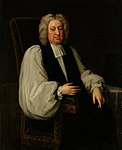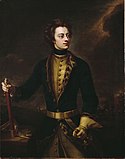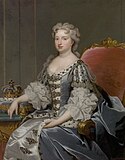Michael Dahl
| Michael Dahl | |
 Självporträtt i National Portrait Gallery, London | |
| Född | omkring 1659 Stockholm |
|---|---|
| Död | 20 oktober 1743 London |
| Nationalitet | |
| Konstnärskap | |
| Fält | Måleri |
| Motiv | Porträtt |
| Rörelse | Barocken |
| Redigera Wikidata (för vissa parametrar) | |
Michael Dahl, född omkring 1659 i Stockholm, död 20 oktober 1743 i London, var en svensk porträttmålare verksam i England. Han skolades av David Klöcker Ehrenstrahl och var far till Mikael Dahl (1708–1741).
Biografi
Michael Dahl lärde sig barockmåleriets teknik i Ehrenstrahls verkstad. År 1678 följde han en engelsk köpman till London, varifrån han begav sig ut på en längre konstresa till Paris och Rom. I sistnämnda stad målade han 1687 ett porträtt av drottning Kristina.
Senare verkade han i London i många år. Dit kom han 1682. Här framstod han snabbt som en värdig utmanare till tyskfödde Godfrey Kneller, som var periodens mest populära porträttmålare i hovkretsar. En kort period mellan 1685 och 1689 arbetade han också i Italien. I England gjorde Dahl flera arbeten för hertigen av Somerset och för drottning Anne och hennes gemål.
I England är Michael Dahl bland annat representerad på National Portrait Gallery och i Sverige finns han på Gripsholm med ett porträtt av den unge Karl XII, vid Nationalmuseum[1] i Stockholm och vid Norrköpings konstmuseum.[2]
Bildgalleri
- Drottning Anna av Storbritannien (tidigt 1700-tal).
- Francoise Leijoncrona (1700).
- Sjöofficeren Cloudesley Shovell (1702–1705)
- Christian Ludvig II av Mecklenburg-Schwerin (1704).
- Prins Georg av Danmark (1704).
- Drottning Anna av Storbritannien (1705).
- Överste Daniel Parke (1705).
- Amiral George Rooke (1705).
- Sjöofficeren Thomas Hopsonn (1705-1708).
- Kung Karl XII (1710-1717).
- Drottning Anna av Storbritannien (1714).
- Kung Karl XII (1714).
- Okänd man (1720).
- Charles Robartes, 2:e earlen av Radnor (före 1723).
- Alexander Pope (1727)
- Drottning Caroline av Ansbach (1730).
- Jonathan Swift (1734).
- Damporträtt (okänt år).
- Porträtt av en framstående dam under ett träd (okänt år).
- Sir John Pratt (okänt år).
- James Butler, 2:e hertig av Ormonde (okänt år).
Litteratur
- Wilhelm Nisser: Michael Dahl and the contemporary Swedish school of painting in England. Avhandling. (Uppsala : Almqvist & Wiksell, 1927)
- Svenskt konstnärslexikon del I, sid 330–332, Allhems Förlag, Malmö. Libris 8390293
Källor
 Den här artikeln är helt eller delvis baserad på material från Nordisk familjebok, Dahl, Mikael, 22 oktober 1906.
Den här artikeln är helt eller delvis baserad på material från Nordisk familjebok, Dahl, Mikael, 22 oktober 1906.
Referenser
- ^ Nationalmuseum
- ^ Norrköpings konstmuseum. (2000 ;). Norrköpings konstmuseum : katalog. Norrköpings konstmuseum. ISBN 91-88244-22-9. OCLC 186037488. https://www.worldcat.org/oclc/186037488. Läst 29 mars 2020
Externa länkar
 Wikimedia Commons har media som rör Michael Dahl.
Wikimedia Commons har media som rör Michael Dahl.- Michael Dahl hos Europeana
Media som används på denna webbplats
Парадный портрет королевы Анны
| Caption from Historical Portraits Picture Archive website |
|---|
|
This heroic image of Sweden's warrior king is related to a portrait that Dahl -a fellow countryman- painted for the Swedish envoy in London, Count Carl Gyllenborg c.1714 (Nationalmuseum, Stockholm). In the absence of the sitter, who was for most of his short life, engaged in warfare against his neighbours, Dahl is believed to have modelled the head after a sculpture. This, if it is true, may be detected in the rather hagiographical treatment which remains, nonetheless, appropriate to a courageous and accomplished general and a national hero. The commission is testament to the way in which Dahl, until near the end of his career an understated but accomplished politician, remained in contact with influential Swedish circles in London at the height of his English success. Count Gyllenborg remains an enigmatic figure in the diplomatic history of the time- a connoisseur of literature and painting, and at the same time an intriguer who was to be arrested by the English authorities some three years in 1717 for conspiring with the Jacobites. This event, which led to a suspension of diplomatic relations between Britain and Sweden, ended Gyllenborg's career in England, though not, of course, that of Dahl, whose tact and loose association with the emigre community kept him free of suspicion. The events of 1717, however, ended Britains love affair with the dashing Swedish king, and provide, therefore, a probable terminus ante quem for the execution of this portrait. Some considerable variation has been employed in the production of this version, which shares only the head with the Stockholm portrait. In the latter the King is shown without armour, wearing a fur-lined uniform coat, resting his baton on a convenient plinth and with his gloved right hand gripping his sword hilt. In our painting the details of costume have been generalised, but with the introduction of the cuirass and the employment of the classic stance of the commander, considerable impact has been gained. The painting's authority as a new composition rests not least upon the various pentimenti that show some debate over the position of the marshals baton, and over the altered positioning of a belt over the adjacent part of the sitter's buffcoat. The besieged town in the background is suggested with superb economy, unmistakeably in the hand of the master, whilst the swift, hogshair brushstokes that make up the night sky again show the verve that the studio version would lack. This triumphant image of the king reflects the military expansion that marked Swedens history following Carl's accession in 1697. In 1700 he invaded the rival Kingdom of Denmark (which then included Norway), and in the same year safeguarded his other flank by defeating Russia at Narva. For the next six years he turned his attention southwards and waged a successful campaign against Poland and Saxony. Defeat by the armies of Peter the Great at Pultowa in July 1709 brought an end to this run of victories, and the king was forced to retire to Turkey. His eventual return from that country in 1714 may well have inspired the commission to Dahl. In 1715 Sweden was once more at war with Norway, and after a war of three years, marked by conditions of cold and great hardship, Carl was killed at the siege of Frederikshald by an enemy musket ball. |
| Caption from the museum's website |
|---|
|
A three-quarter-length portrait to the right of Admiral Sir George Rooke, Admiral of the Fleet. He wears a gold-braided red cloth coat with wide sleeves, grey-brown full-bottomed wig and a white neck-cloth. His right arm rests on the muzzle of a cannon and he holds a telescope in his left hand. Behind him in both the right and left backgrounds, is a depiction of the Battle of Malaga, 1704. Admiral Rooke's flagship, the 'Royal Katharine' with the Union flag at the main, is seen in port-quarter view, engaging the 'Foudroyant', which was the flagship of the Franco-Spanish fleet under the Comte de Toulouse, an illegitimate son of Louis XIV. Though inconclusive, the Battle of Malaga was the only fleet action fought at sea during the War of the Spanish Succession. This portrait is one of a series commissioned for the Royal Collection at the time of Queen Anne and was presented to Greenwich Hospital by George IV in 1824. The Swedish painter travelled to London in 1682, where he became acquainted with Godfrey Kneller. In 1685, he left for Europe and returned to London in 1689 where he remained. During Dahl's absence, Kneller consolidated his supremacy as the fashionable portrait painter, although the prolific Dahl was his closest competitor. Politically, Kneller supported the ascendant Whigs, while Dahl was a Tory. The death of Kneller in 1723 left Dahl the principal London portraitist. |
Sir John Pratt, by Michael Dahl (died 1743), given to the National Portrait Gallery, London in 1877. See source website for additional information.
This set of images was gathered by User:Dcoetzee from the National Portrait Gallery, London website using a special tool. All images in this batch have been confirmed as author died before 1939 according to the official death date listed by the NPG.Alexander Pope (21 May 1688 – 30 May 1744) is generally regarded as the greatest English poet of the eighteenth century,
See source website for additional information.
This set of images was gathered by User:Dcoetzee from the National Portrait Gallery, London website using a special tool. All images in this batch have been confirmed as author died before 1939 according to the official death date listed by the NPG.Porträtt av Anna av Storbritannien (1665-1714), dotter of Jakob II av England














































